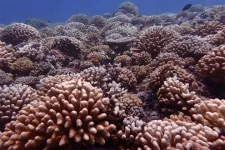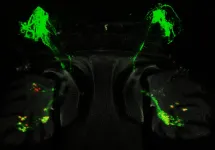(Press-News.org) Certain brightly colored coral species dotting the seafloor may appear indistinguishable to many divers and snorkelers, but Florida State University researchers have found that these genetically diverse marine invertebrates vary in their response to ocean warming, a finding that has implications for the long-term health of coral reefs.
The researchers used molecular genetics to differentiate among corals that look nearly identical and to understand which species best coped with thermal stress. Their research was published in the journal Ecology.
"Being able to recognize the differences among these coral species that cannot be identified in the field -- which are known as 'cryptic species' -- will help us understand new ways for how coral reefs maintain resilience in the face of disturbance," said Associate Professor of Biological Science Scott Burgess, the paper's lead author.
The researchers were studying the coral ecosystem at the island of Moorea in French Polynesia when a coral bleaching event struck in 2019.
Corals get their color from algae that live in their tissues and with which they have a symbiotic relationship. But when corals are stressed -- by high water temperature, for example -- algae leave the coral, which turns white, hence the term "bleaching." Bleached corals are not dead, but they are more vulnerable and more likely to die.
Most of the coral at Moorea belong to the genus Pocillopora. During the event, the researchers saw that about 72 percent of the coral colonies from this genus bleached, and up to 42 percent died afterward.
At first, it seemed that the largest colonies were more likely to bleach, but when the scientists examined tissue samples from the coral, they found that colonies belonging to a certain genetic lineage, not coral size, was most important in determining the fate of the corals.
"Because Pocillopora species look so similar, they cannot be reliably identified in the field, which, in the past, has forced researchers to study them as a single group," said Erika Johnston, a postdoctoral researcher in the Department of Biological Science and a co-author of the paper. "Molecular genetics allows us to reconstruct their evolutionary ancestry and are an essential step to species identification in this case."
About 86 percent of the Pocillopora corals that died belonged to a group that shares a set of DNA variations, which is known as a haplotype and reflects their common evolutionary ancestry.
"The good news is that not all of the corals died from bleaching, and many species survived," Burgess said. "The bad news is that the species that died is, as far as we are aware at the moment, endemic to that specific region. So on the one hand, we're worried about losing an endemic species, but on the other hand, our results show how co-occurring cryptic species can contribute to coral resilience."
It's an ecological analogy to having a diverse financial portfolio, where a variety of investments decreases the likelihood of a complete loss.
"Having multiple species that perform a similar function for the reef ecosystem but differ in how they respond to disturbances should increase the chance that Pocillopora corals continue to perform their role in the system, even though the exact species may be shuffled around," Burgess said.
Maintaining healthy ecological portfolios may be a better management option than attempting to restore a specific species.
"If we maintain the right type of diversity, nature in a way can pick the winners and losers," Burgess said. "However, the worry for us scientists is that unless the leaders of governments and corporations take action to reduce CO2 emissions, ecological portfolios that can maintain coral reef resilience will be increasingly eroded under current and ongoing climate change. This is concerning because coral reef ecosystems provide economic, health, cultural and ecological goods and services that humans rely on."
Future research will look into the composition of the algae that live inside the coral, the depth distributions of each cryptic coral species and the evolutionary relationships among the cryptic species.
INFORMATION:
Researchers from the Hong Kong University of Science and Technology, the Scripps Institution of Oceanography and California State University, Northridge contributed to this study.
This work was conducted as part of a National Science Foundation grant awarded to Burgess.
The electron is one of the fundamental particles in nature we read about in school. Its behavior holds clues to new ways to store digital data.
In a study published in Nano Letters, physicists from Michigan Technological University explore alternative materials to improve capacity and shrink the size of digital data storage technologies. Ranjit Pati, professor of physics at Michigan Tech, led the study and explains the physics behind his team's new nanowire design.
"Thanks to a property called spin, electrons behave like tiny magnets," Pati said. "Similar to how a bar magnet's magnetization is dipolar, pointing from south to north, ...
The Volcano Alert Level (VAL) system, standardized by the United States Geological Survey (USGS) in 2006, is meant to save lives and keep citizens living in the shadow of an active volcano informed of their current level of risk.
A new study published in Risk Analysis suggests that, when an alert remains elevated at any level above "normal" due to a period of volcanic unrest, it can cause a decline in the region's housing prices and other economic indicators. Because of this, the authors argue that federal policymakers may need to account for the effects of prolonged volcanic unrest -- not just destructive eruptions -- in the provision of disaster relief funding.
A team of geoscientists and statistical experts examined the historical relationship ...
As researchers push the boundaries of battery design, seeking to pack ever greater amounts of power and energy into a given amount of space or weight, one of the more promising technologies being studied is lithium-ion batteries that use a solid electrolyte material between the two electrodes, rather than the typical liquid.
But such batteries have been plagued by a tendency for branch-like projections of metal called dendrites to form on one of the electrodes, eventually bridging the electrolyte and shorting out the battery cell. Now, researchers at MIT and elsewhere have found ...
Even though a fruit fly doesn't have ears, it can hear with its antennae. In a END ...
The first known study to explore optimal outpatient exam scheduling given the flexibility of inpatient exams has resulted in shorter wait times for magnetic resonance imaging (MRI) patients at END ...
FINDINGS
A new UCLA study shows that while men and women who have high muscle mass are less likely to die from heart disease, it also appears that women who have higher levels of body fat -- regardless of their muscle mass -- have a greater degree of protection than women with less fat.
The researchers analyzed national health survey data collected over a 15-year period and found that heart disease-related death in women with high muscle mass and high body fat was 42% lower than in a comparison group of women with low muscle mass and low body fat. However, women who had high muscle mass and low ...
A global review of coastal drowning science has found there is only one study worldwide that has evaluated beach safety education programs in schools.
Researchers from UNSW's Beach Safety Research Group have conducted the first in-depth review specific to coastal drowning.
The study, published in PLOS ONE, reviewed 146 coastal drowning studies from around the world.
"We found that evaluation of coastal drowning prevention strategies is rare," said William Koon, the lead author of the study and a PhD candidate in the School of Biological, Earth ...
The National Science Foundation (NSF) selected an NYU Tandon School of Engineering professor who is developing new approaches to training deep learning (DL) artificial intelligence frameworks, to receive its most prestigious award for promising young academics.
Anna Choromanska, an assistant professor in the Department of Electrical and Computer Engineering (ECE), received a 2021 NSF Faculty Early Career Development Award, more widely known as a CAREER Award, which supports early-career faculty who have the potential to serve as academic role models in research and education.
A five-year, $532,892 grant will support a project that focuses on new, more efficient ways of training ...
The continuous improvement of imaging technology holds great promise in areas where visual detection is necessary, such as with cancer screening. Three-dimensional imaging in particular has become popular because it provides a more complete picture of the target object and its context.
"More doctors and radiologists are looking at these 3D volumes, which are new technologies that allow you to look not just at one image, but a set of images," said UC Santa Barbara psychology professor Miguel Eckstein(link is external), whose expertise lies in the field of visual search. "In some imaging modalities this gives doctors information about volume and it allows them to segment what they're interested in."
Common wisdom is that with all ...
Bring on Twilight. Lee Child's Jack Reacher? Yes, please. More of James Patterson's Alex Cross while we're at it. And let's finish off with revisiting the million-plus words of the Harry Potter saga.
No one will confuse the above book series with high literature. But a new study published in the journal Reading and Writing shows that the more people read any kind of fiction -- even mass market stuff sniffily derided as pulp -- the better their language skills are likely to be.
The piece was written by Sandra Martin-Chang, professor of education in the Faculty of Arts and Science, and PhD student Stephanie Kozak. They found that people who enjoyed reading fiction for leisure and who identified as a reader scored higher on language tests, whereas ...



